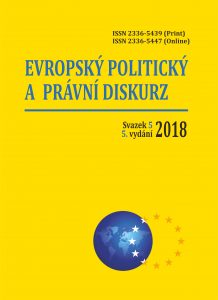DOI: 10.46340/eppd.2024.11.6.1
Svitlana Koch, D.Sc. in Political Science
I.I.Mechnikov Odesa National University, Odesa, Ukraine
Yuliia Uzun, D.Sc. in Political Science
I.I.Mechnikov Odesa National University, Odesa, Ukraine
How to cite: Koch, S., & Uzun, Y. (2024). Spatial Imagination In Politics: the Strategic Role of Phantom Borders and Imaginary Territories. Evropský politický a právní diskurz, 11, 6, 5-12. https://doi.org/10.46340/eppd.2024.11.6.1
Abstract
This article examines the role of ‘phantom’ and ‘imaginary’ spaces in shaping sociopolitical and geopolitical landscapes, particularly in Eastern Europe. These phantom borders, often tracing historical frontiers from former empires, continue to influence regional identities, political mobilization, and conflict dynamics. The concept that space defines us as much as we define it is particularly evident, as phantom spaces provide a basis for political action and identity formation.
In today’s political processes, ‘images,’ ‘representations,’ and ‘mental constructs’ play essential roles in mobilizing social groups and supporting geopolitical ambitions. Phantom borders serve not only as psychological anchors that maintain historical identities but also as tools for political actors to reshape territories and foster cross-border cooperation. With the growth of virtual dimensions of political space, including informational and mental realms, imaginary borders now function as frameworks for political action.
Approaches to studying these borders reveal how they affect identity, acting as ‘scars of history’ that maintain past identities or serve as arenas for ideological and geopolitical competition. By linking regional loyalties to the state, promoting nationalism, and reinforcing sovereignty, these borders influence political landscapes, from voter preferences to narratives within memorial policies.
In Eastern Europe, the establishment of cross-border regions, such as Euroregions, illustrates how phantom spaces pragmatically contribute to structuring identity and governance. This multidimensional understanding of space, blending tangible and imagined elements, highlights the complexity of modern political space, where virtual and symbolic dimensions intersect with physical borders, creating new layers of political reality.
Keywords: phantom borders, geopolitics, center-periphery systems, political space, region, political process, Eastern European countries, memorial policy.
References
Agnew, J., & O’Tuathail, G. (1992). Geopolitics and Discourse: Practical Geopolitical Reasoning in American Foreign Policy. Political Geography, 11, 190-204. https://doi.org/10.1016/0962-6298(92)90048-X
Billé, F. (2013). Territorial Phantom Pains (and other Cartographic Anxieties). Environment and Planning D: Society and Space, 31(1), 163-178. https://doi.org/10.1068/d2011
Byman, D. L., & King, Ch. (2012). The Mystery of Fantom States – Summer 2012. The Washington Quarterly, 35(3), 43-57. https://doi.org/10.1080/0163660X.2012.703580
Dalby, S. (1996). Writing critical geopolitics: Campbell, Ó Tuathail, Reynolds and dissident skepticism. Political Geography, 15(6-7), 655-660. https://doi.org/10.1016/0962-6298(96)00035-2
Demski, D. (2015). Marking and Crossing over Invisible Borders in Everyday Life. Research in Social Change, 7(2),145-173.
Koch, S. V. (2018). Memorialna polityka susidiv Ukrainy: vid stratehii natsionalnoho suverenitetu do «velykykh derzhav» [The Memorial Policy of Ukraine’s Neighbors: from the Strategy of National Sovereignty to the “Great Powers”]. Politicus, 4, 46-50. http://doi.org/10.24195/2414-9616-2018-4-46-50 [in Ukrainian].
Kolosov, V., & Więckowski, M. (2018). Border Changes in Central and Eastern Europe: An Introduction. Geographia Polonica, 91(1), 5-16. https://doi.org/10.7163/GPol.0106
Úrad vlády Slovenskej republiky [Office of the Government of the Slovak Republic] (2015). Koncepcia štátnej politiky Slovenskej republiky vo vzťahu k Slovákom žijúcim v zahraničí na roky 2016–2020 [The Concept of the State Policy of the Slovak Republic in Relation to Slovaks Living Abroad for the Years 2016-2020]. https://web.archive.org/web/20220123214156/https://rokovania.gov.sk/RVL/Material/12356/1 [in Slovak].
Koter, M. (2001). “Kresy” as a Specific Type of Borderland – It’s Origin and Characteristics.
Geographica Slovenica, 34(1), 131-148. https://web.archive.org/web/20240430024946/https://giam.zrc-sazu.si/sites/default/files/gs_clanki/GS_3401_131-148.pdf
Lipset, S., & Rokkan, S. (1967). Cleavage Structures, Party Systems, and Voter Alignments. Party Systems and Voter Alignments: Cross-National Perspectives, 1-64.
Maslov, Y. (2014). Historical Background оf Transformation Central and Eastern European Region in a Special Geopolitical Subjectivity. Evropský politický a právní diskurz [European Political and Law Discourse], 1(3), 59-67 https://eppd13.cz/wp-content/uploads/2014/2014-1-3/08.pdf
Miller, T. (2014). Border Patrol Nation: Dispatches from the Front Lines of Homeland Security. San Francisco: City Lights Publishers.
Mynystersky svet. Portal za obshchestveny konsultatsyi [Council of Ministers. Public Consultation Portal] (2014). Natsionalna strategiya za bŭlgarskite grazhdani i istoricheskite bŭlgarski obshtnosti po sveta [National Strategy for Bulgarian Citizens and Historical Bulgarian Communities Around the World]. https://web.archive.org/web/20241216192831/https://www.strategy.bg/StrategicDocuments/View.aspx?lang=bg-BG&Id=938%20 [in Bulgarian].
Newman, D. (2006). The Lines that Continue to Separate Us: Borders in Our “Borderless” World. Progress in Human Geography. London: SAGE, 30(2), 143-161. https://doi.org/10.1191/0309132506ph599xx
O’Tuathail, G. (eng. Toal G.), & Dalby, S. (1998). Re-Thinking Geopolitics? London-NY: Routledge.
Repas, Z. (ed.) (2013). Policy for Hungarian Communities Abroad. Strategic Framework for Hungarian Communities Abroad. Budapest: Magyar Közlöny Lapés Könyvkiadó Kft. https://web.archive.org/web/20240730071153/https://bgazrt.hu/wp-content/uploads/2019/02/policy_2013.pdf
Gov.pl. Serwis Rzeczypospolitej Polskiej [Gov.pl. Service of the Republic of Poland] (2012). Priorytety polskiej polityki zagranicznej na lata 2012-2016 [Priorities of Polish Foreign Policy for 2012-2016]. https://www.gov.pl/web/polskapomoc [in Polish].
Putnam, R. D., Leonardi, R., & Nanetti, R. Y. (1994). Making Democracy Work: Civic Traditions in Modern Italy. Princeton: Princeton University Press.
Rokkan, S. (1975). Dimensions of State Formation and Nation-Building: A Possible Paradigm for Research on Variations within Europe. The Formation of National States in Europe. Princeton NJ: PUP, 562-600.
Rykaіa, A. (2013). Ethno-Religious Heritage of Former Eastern Territories of the Polish-Lithuanian Commonwealth in Contemporary Poland. European Spatial Research and Policy, 20 (1), 49-70. https://doi.org/10.2478/esrp-2013-0003
Said, E. W. (1979). Orientalism. NY: Vintage Books Edition.
Shnirelman, V. A. (2001). The Value of the Past: Myths, Identity and Politics in Transcaucasia. Osaka, Japan: National Museum of Ethnology. https://web.archive.org/web/20220325072843/https://abkhazworld.com/aw/Pdf/Shnirelman_V_A_The_Value_of_the_Past_Myths_Identity_and_Politics_in_Transcaucasia_2001.pdf
Monitorul oficial [The official monitor] (2017). Strategiei naționale pentru românii de pretutindeni pentru perioada 2017-2020 [National Strategy for Romanians Everywhere for the Period 2017-2020]. https://web.archive.org/web/20241216194648/https://lege5.ro/MonitorOficial/mongq3danzygiyq/monitorul-oficial-partea-i-nr-485-27-06-2017 [in Romanian].
Von Hirschhausen, B. (2017). The Heuristic Interest of the Concept of “Phantom Borders” in the Understanding of Cultural Regionalization. L’Espace géographique [Geographical Space]. Paris: Balin, 46 (2), 106-125.
Wallerstein, E. (1995). Does India Exist? In: Wallerstein E. Unthinking Social Science. The Limits of Nineteenth-Century Paradigms. Cambridge, 131-134.



